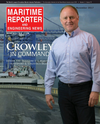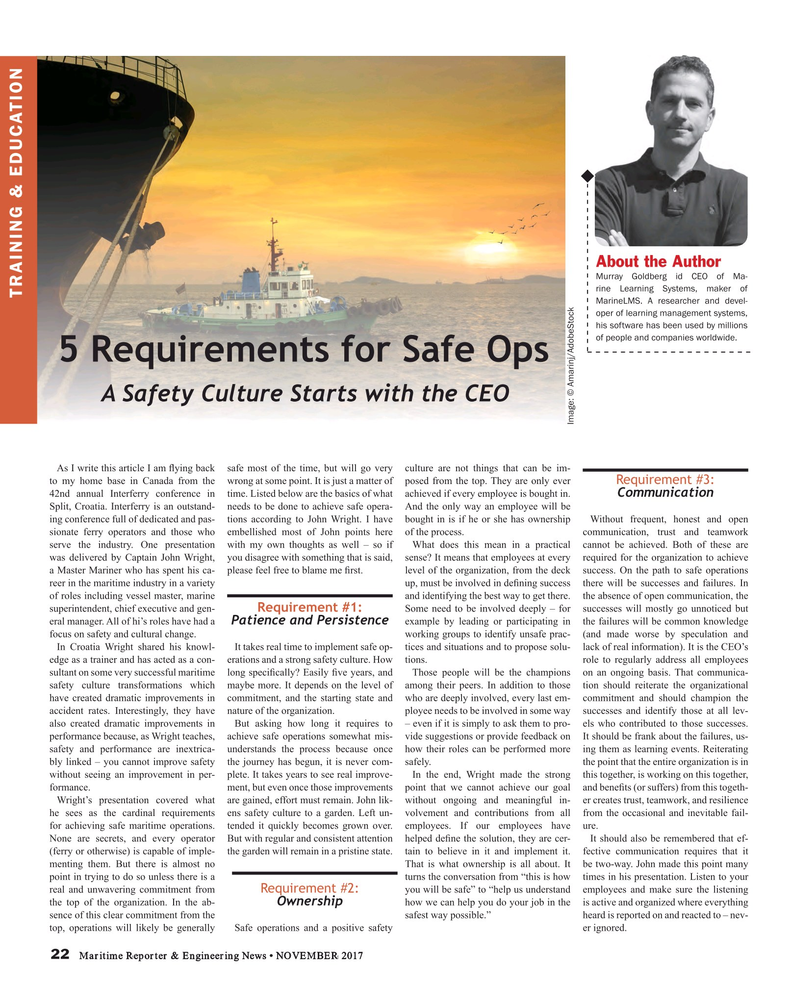
Page 22: of Maritime Reporter Magazine (November 2017)
The Workboat Edition
Read this page in Pdf, Flash or Html5 edition of November 2017 Maritime Reporter Magazine
About the Author
Murray Goldberg id CEO of Ma- rine Learning Systems, maker of
MarineLMS. A researcher and devel- TRAINING & EDUCATION oper of learning management systems, his software has been used by millions of people and companies worldwide.
5 Requirements for Safe Ops
A Safety Culture Starts with the CEO
Image: © Amarinj/AdobeStock
As I write this article I am ? ying back safe most of the time, but will go very culture are not things that can be im- to my home base in Canada from the wrong at some point. It is just a matter of posed from the top. They are only ever
Requirement #3: 42nd annual Interferry conference in time. Listed below are the basics of what achieved if every employee is bought in.
Communication
Split, Croatia. Interferry is an outstand- needs to be done to achieve safe opera- And the only way an employee will be ing conference full of dedicated and pas- tions according to John Wright. I have bought in is if he or she has ownership Without frequent, honest and open sionate ferry operators and those who embellished most of John points here of the process. communication, trust and teamwork serve the industry. One presentation with my own thoughts as well – so if What does this mean in a practical cannot be achieved. Both of these are was delivered by Captain John Wright, you disagree with something that is said, sense? It means that employees at every required for the organization to achieve a Master Mariner who has spent his ca- please feel free to blame me ? rst. level of the organization, from the deck success. On the path to safe operations reer in the maritime industry in a variety up, must be involved in de? ning success there will be successes and failures. In of roles including vessel master, marine and identifying the best way to get there. the absence of open communication, the superintendent, chief executive and gen- Some need to be involved deeply – for successes will mostly go unnoticed but
Requirement #1: eral manager. All of hi’s roles have had a example by leading or participating in the failures will be common knowledge
Patience and Persistence focus on safety and cultural change. working groups to identify unsafe prac- (and made worse by speculation and
In Croatia Wright shared his knowl- It takes real time to implement safe op- tices and situations and to propose solu- lack of real information). It is the CEO’s edge as a trainer and has acted as a con- erations and a strong safety culture. How tions. role to regularly address all employees sultant on some very successful maritime long speci? cally? Easily ? ve years, and Those people will be the champions on an ongoing basis. That communica- safety culture transformations which maybe more. It depends on the level of among their peers. In addition to those tion should reiterate the organizational have created dramatic improvements in commitment, and the starting state and who are deeply involved, every last em- commitment and should champion the accident rates. Interestingly, they have nature of the organization. ployee needs to be involved in some way successes and identify those at all lev- also created dramatic improvements in But asking how long it requires to – even if it is simply to ask them to pro- els who contributed to those successes. performance because, as Wright teaches, achieve safe operations somewhat mis- vide suggestions or provide feedback on It should be frank about the failures, us- safety and performance are inextrica- understands the process because once how their roles can be performed more ing them as learning events. Reiterating bly linked – you cannot improve safety the journey has begun, it is never com- safely. the point that the entire organization is in without seeing an improvement in per- plete. It takes years to see real improve- In the end, Wright made the strong this together, is working on this together, formance. ment, but even once those improvements point that we cannot achieve our goal and bene? ts (or suffers) from this togeth-
Wright’s presentation covered what are gained, effort must remain. John lik- without ongoing and meaningful in- er creates trust, teamwork, and resilience he sees as the cardinal requirements ens safety culture to a garden. Left un- volvement and contributions from all from the occasional and inevitable fail- for achieving safe maritime operations. tended it quickly becomes grown over. employees. If our employees have ure.
None are secrets, and every operator But with regular and consistent attention helped de? ne the solution, they are cer- It should also be remembered that ef- (ferry or otherwise) is capable of imple- the garden will remain in a pristine state. tain to believe in it and implement it. fective communication requires that it menting them. But there is almost no That is what ownership is all about. It be two-way. John made this point many point in trying to do so unless there is a turns the conversation from “this is how times in his presentation. Listen to your real and unwavering commitment from you will be safe” to “help us understand employees and make sure the listening
Requirement #2: the top of the organization. In the ab- how we can help you do your job in the is active and organized where everything
Ownership sence of this clear commitment from the safest way possible.” heard is reported on and reacted to – nev- top, operations will likely be generally Safe operations and a positive safety er ignored. 22 Maritime Reporter & Engineering News • NOVEMBER 2017
MR #11 (18-25).indd 22 MR #11 (18-25).indd 22 11/5/2017 1:05:24 PM11/5/2017 1:05:24 PM

 21
21

 23
23
